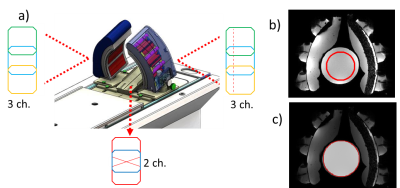1091
Towards motion robust MRT during Microwave Hyperthermia by integrating an 8-channel receiver coil array into the MRcollar1Department of Radiotherapy, Erasmus Medical Center Rotterdam, Rotterdam, Netherlands, 2Department of Radiology and Nuclear Medicine, Erasmus Medical Center Rotterdam, Rotterdam, Netherlands, 3Department of Electrical Engineering, Eindhoven University of Technology, Eindhoven, Netherlands
Synopsis
In the head and neck region, precise heating and temperature monitoring is a challenge. The MRcollar, an MR compatible head and neck microwave hyperthermia applicator has been developed for conformal heating and to enable MR thermometry (MRT) during the treatment. To deliver on the needs of accurate temperature monitoring, the MRcollar has been equipped with 8-channel receiver coil array. This coil array improves increased the SNR by 5 times compared to the body coil of the MRcollar. Increase in the SNR also led to improvement in the MRT precision, from 0.91 °C to 0.37 °C.
Introduction
In the head and neck region, precise heating and temperature monitoring is a challenge. The MRcollar, an MR compatible head and neck microwave hyperthermia applicator has been developed for conformal heating and to enable MR thermometry (MRT) during the treatment. MRT has great potential to deliver on temperature monitoring needs but the precision and speed requirements demand high signal-to-noise-ratio (SNR) measurements. Hereto, we developed an integrated applicator-multichannel receiver coil array concept for high SNR performance and parallel imaging by near-skin receiving the radio frequency signals of the MR imaging [1]. This concept was used in the MRcollar that has twelve antennas for heating and now incorporates eight MR-receive coils. Herein, we quantify the SNR and MRT precision gain that the integrated receive coils offer against receiving the signals by the body coil of the MR scanner.Methods
The MRcollar (fig. 1a) consists of two crescent moon-shaped shells each consisting of six antenna modules in a 2 x 3 arrangement placed around the head and neck for 12 antenna setup. Every module contains a printed Yagi-Uda antenna submerged in water and operating at 433.92 MHz. The MRcollar houses 8-channel MR receiver coil array tuned to 63.89 MHz for MR imaging at 1.5 T. Each of the moon-shaped shells include a 3-channel receive coil array (a bottom (15 x 8 cm), a central (15 x 12 cm) and a top (15 x 8 cm) rectangular shaped loops) and the head rest includes a 2-channel receive coil array (butterfly coil 20 x 9 cm and 9 x 9 cm rectangular shaped loops).The cylindrical phantom provided by the MR vendor as well as the standard MRT sequence, i.e. a fast gradient echo sequence was used for the evaluation with the following parameters: TR: 100 ms, TE: 19.2 ms, flip angle 30°, resolution 1.25 x 1.25 x 3 mm3, matrix resolution 256 x 256, total acquisition time 25.6 s. In total, 12 acquisitions were made. SNR was calculated in a region of interest (ROI) (fig. 1b) using the dual image subtraction method [2]. Temporal MRT precision was calculated for each voxel assuming that the temperature remained constant during the experiments. PRFS thermometry was calculated using the first acquisition as the baseline, the voxels which are highlighted in red in fig. 1c were used for field drift correction [3].
Results
Example magnitude images for the body coil as receiver and the MRcollar receiver coil array are visualized in the first column of fig. 2, and example MRT and precision maps are given in the columns 2-4 of fig 2. SNR was 23 when the phantom was imaged using the body coil as a receiver and SNR was improved around five-fold to 120 for the 8-channel receiver coil of the MRcollar. Since MRT is a differential method, improvement in the SNR also led to an improved MRT precision. The lowest measured standard deviation reduced from 1.8 °C for the body coil acquisition to 0.55 °C for the MRcollar receiver coils. The average standard deviation in the ROI reduced from 0.91 °C for the body coil to 0.37 °C for the MRcollar coils.Conclusion
Integrating the receiver coils in the MRcollar led to the an important improvement in SNR. The 5-fold increase in the SNR improves the accuracy and the precision of the MRT results since MRT is a differential measurement method which amplifies the effect of the noise. In addition to the SNR benefits, the integrated receiver coil array also allows for the use of advanced MR techniques, such as parallel imaging, to enable faster acquisition times for correction of the impact of respiratory motion. Hence, integration of the receiver arrays close to the skin into MR hyperthermia devices provides a crucial step towards reliable temperature monitoring during hyperthermia.Acknowledgements
This work was developed within the framework of COST Action MyWAVE CA17115312 and it was funded by the Dutch Cancer Society grants EMCR 2012-5472 and 11368.References
[1] Sumser K, Bellizzi GG, Forner R, Drizdal T, Tamames JA, Van Rhoon GC, Paulides MM. Dual-Function MR-guided Hyperthermia: An Innovative Integrated Approach and Experimental Demonstration of Proof of Principle. IEEE Transactions on Biomedical Engineering. 2020 Jul 29.
[2] Goerner FL, Clarke GD. Measuring signal‐to‐noise ratio in partially parallel imaging MRI. Medical physics. 2011 Sep;38(9):5049-57.
[3] Sumser K, Bellizzi GG, van Rhoon GC, Paulides MM. The potential of adjusting water bolus liquid properties for economic and precise MR thermometry guided radiofrequency hyperthermia. Sensors. 2020 Jan;20(10):2946.
Figures

